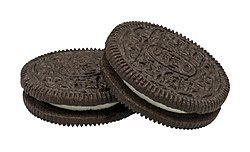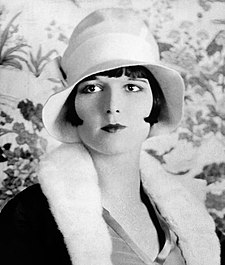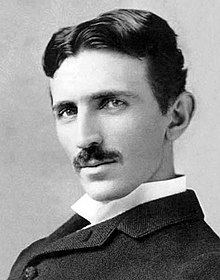Came home. Stopped at Joe's and Ollie's. Ate lunch at Perry. Rained a little. Got home about 5 p.m.
The daily diary entries from Ruth Catherine McKenzie McCoy. Her daughter, author Fran Baker, has included photos, historic notes and "old-time" recipes following the entries. Readers are welcome to comment.
Tuesday, July 31, 2012
Monday, July 30, 2012
Monday, July 30, 1934
Annie gave me a pen. Helped Aunt Jessie a little. Daddy went to Clay. Had fried rabbit for dinner at Henry's. Mart's and Emmett were there.
Sunday, July 29, 2012
Sunday, July 29, 1934
Had fried rabbit for breakfast and fried chicken for dinner at Joe's. Emmett and Melvin and Henry and Newt were there. Shot rabbits. I stayed at Mart's all night.
Saturday, July 28, 2012
Saturday, July 28, 1934
Ollie, Ruby, Minnie and Joe came up here for dinner. Then Ruby, Henry and I went to Palmer. Stopped at Nell's. Went down to Joe's. I learned to drive.
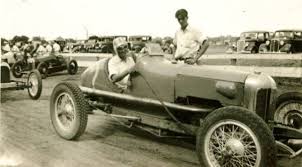 July 27, 1934 - Winfield, Kansas |
| Tex West of Dallas, Texas is shown here on the front straightaway of the race track at the Cowley County Fairgrounds, Winfield, Kansas. That is the Mayfield Special #C13 of Carl Mayfield of Wichita, Kansas backed up next to the fence at left in this photo. As dangerous as it was, the cars actually pitted along that inside rail and stayed there throughout the racing program when not competing. |
Friday, July 27, 2012
Friday, July 27, 1934
Stayed all night with Gladys last night. Mother came up and we had a fried chicken dinner. We listened to the radio with Sue and Howard.
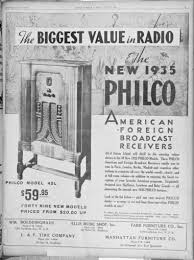 |
| July 27, 1934 ad for new radio |
Thursday, July 26, 2012
Thursday, July 26, 1934
Rita Mae stayed here at Henry's last night. Then Ruby and Gladys and Emmett and Melvin came up. Took pictures.
 |
| Clay Center Cousins - July 26, 1934 Front Row (L-R) Gladys, Ruth, Ruby, Rita Mae Back Row (L-R) Emmett and Melvin |
Wednesday, July 25, 2012
Wednesday, July 25, 1934
Rained. Rita Mae and I walked to Susie's. Mother and Mart's went to Clay. Rita Mae and I came back and made candy.
 |
| Kansas City Star - July 25, 1934 History repeating itself? |
Tuesday, July 24, 2012
Tuesday, July 24, 1934
Rita Mae and I practiced up at Susie's this morning. Went to show at Palmer. Saw "Dollar Down Family." Sure good.
 |
| Heim No. 20 fire station (former Heim Brewery) Guinotte and North Montgall, Kansas City, Missouri The Brewery was well-known in the Midwest for its lager beer in the late 19th and early 20th centuries. After the Prohibition-era demise of the brewery, Heim No. 20 operated as a Kansas City fire station. |
Monday, July 23, 2012
Monday, July 23, 1934
Mother is still sick. Daddy and I went down to Mart's for dinner. I stayed all night at Rita Mae's.
 |
| Helen Stephens (1918-1994) Growing up on a farm in Callaway County near Fulton, Missouri, Helen loved to run and jump and climb. She also had to work hard on the family farm. By the time she was in high school, her coach was working with her and took her to St. Louis for her first official race. She beat Stella Walsh, a Polish gold medalist in the 1932 Olympics, in the 50-meter dash at 6.6 seconds, setting a new indoor record on a dirt track. On August 4, 1936, eighteen-year-old Helen Stephens set the Olympic world record for the 100-meter event at 11.5 seconds. Her record stood for twenty-four years until Wilma Rudolph beat it in the 1960 Olympics. On August 9, Stephens was the anchor in the 400-meter relay team that also set a world record time of 46.9 seconds. She received a gold medal for each event. Helen returned to Fulton after the Olympics and earned a degree from William Woods College. She paved the way for future female athletes of all ages. She is in the National and United States Track and Field Halls of Fame as well as the Women’s Hall of Fame. Helen Stephens died on January 17, 1994. She is buried in Fulton, Missouri. |
Sunday, July 22, 2012
Sunday, July 22, 1934
Didn't go to church or Sunday school. Rita Mae came up this afternoon. Went with Sue and Henry for ice cream.
 |
| John Dillinger in the morgue - July 22, 1934 Shot and killed by lawmen as he left the Biograph Theater in Chicago, IL.  Public Enemy No. 1 ... a goner. |
Saturday, July 21, 2012
Saturday, July 21, 1934
Mother is sick. Rita Mae and Henry and Daddy and Mr. Lakes and I went to Clay Center. Stopped by Aunt Nellie's for a while.
Friday, July 20, 2012
Friday, July 20, 1934
We ironed. It sure was hot! Rita Mae, Olive and Warren, Mr. Constable and Raymond and Mother and Daddy and I had fish at Joe's.
 |
| Willis Haviland Carrier (November 26, 1876 – October 6, 1950) Carrier was an American engineer and inventor, most widely known as the man who invented modern air conditioning. In Buffalo, New York, on July 17, 1902, in response to a quality problem experienced at the Sackett-Wilhelms Lithographing & Publishing Company of Brooklyn, Willis Carrier submitted drawings for what became recognized as the world's first modern air conditioning system. The 1902 installation marked the birth of air conditioning because of the addition of humidity control, which led to the recognition by authorities in the field that air conditioning must perform four basic functions: 1.) control temperature; 2.) control humidity; 3.) control air circulation and ventilation; 4.) cleanse the air. After several more years of refinement and field testing, on January 2, 1906, Carrier was granted U.S. patent No. 808897 on his invention, which he called an "Apparatus for Treating Air," the world's first spray-type air conditioning equipment. It was designed to humidify or dehumidify air, heating water for the first and cooling it for the second. And the rest, as they say, is history . . . |
Thursday, July 19, 2012
Thursday, July 19, 1934
Washed clothes. Us girls went after the cows. Went down to Olive and Warren's. We played on the swings.
 |
| Buster Keaton (1895-1966) Born in Piqua, Kansas, Keaton was confined to a sanitarium in 1934 for alcoholism. He escaped his straitjacket using a secret learned from the magician Harry Houdini. Keaton later gained control of his drinking. |
Wednesday, July 18, 2012
Wednesday, July 18, 1933
Went over to get some water at Erickson's. Then we went down to Martin Johnson's. Toasted marshmallows.
Tuesday, July 17, 2012
Tuesday, July 17, 1934
In the afternoon Ruby and I went over to the schoolhouse for her singing lessons. Also piano lessons.
Monday, July 16, 2012
Monday, July 16, 1934
Mother, Daddy, Henry and I went down to Joe's. Ate a fried chicken dinner at Ollie's. Rita Mae came back with us.
 |
| St. Louis Kid starring James Cagney (right) Production begins on July 16, 1934 Cagney plays Eddie Kennedy, the pugnacious truck driver who always finds himself in jail and uses a new method of punching guys--using his head (literally)! Kenndy (Cagney) gets embroiled in a "milk war" between a trucking company and striking dairymen - a topical subject of the time. The trucking company is determined to maintain its milk shipments even though the dairymen are on strike. When a dairy worker is murdered, Cagney is accused of the crime and must find the real killer to clear himself. He also must rescue his kidnapped girlfriend (Patricia Ellis). |
Sunday, July 15, 2012
Sunday, July 15, 1934
Went to church this a.m. Went down to Mart's for dinner and supper. Rita Mae wasn't there.
Saturday, July 14, 2012
Saturday, July 14, 1934
I didn't do much today. This evening Mart's had fish here. Joe and Minnie came in.
 |
| July 14, 1934 - Dog Bite Victims Receive Pasteur Treatment Scranton, PA: One of thirteen other dog bite victims, most of them children, receiving an inoculation of the anti-rabies serum, which is being furnished by the city health department. These thirteen victims were all bitten by dog from St.Ann Street in West Scranton. |
Friday, July 13, 2012
Friday, July 13, 1934
Rained. We went over to the ice cream social at Marie's. It hailed. I went home with Gladys.
Thursday, July 12, 2012
Thursday, July 12, 1934
Rita Mae came down today. Then Rita Mae and Ruby and I went down to Joe's.
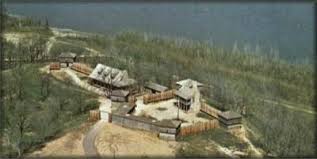 |
| Fort Osage, Missouri During the Lewis and Clark Expedition, William Clark identified a spot on the Missouri River which he felt would make an ideal location for a fort. After the Expedition he returned to this spot in 1808 and constructed what would later become Fort Osage. The fort served as a strategic trading post and military outpost and garrison until it was abandoned in the mid-1820s. Located in Sibley, Missouri, the fort today is operated by Jackson County Parks and Recreation with a professional staff. The Fort Osage Education Center opened in 2007 and features state-of-the-art exhibits, classrooms, auditorium, special exhibit spaces and a gift shop. |
Wednesday, July 11, 2012
Wednesday, July 11, 1934
Daddy went fishing. Went down to Joe's. Ruby came back with me and spent the night. Rita Mae was up and bit and Gladys's were here.
Tuesday, July 10, 2012
Tuesday, July 10, 1934
Stayed at Henry's all day. Went up to Emmett and Melvin's for supper. Had fish. Sure were good. Went back to Henry's.
![[edit] Overview [edit] Overview](http://t3.gstatic.com/images?q=tbn:ANd9GcTDsVescPDc_JQdacYhSXMKXyU-_dDWQzN3FYJeT2WDy3lrdcjC:upload.wikimedia.org/wikipedia/commons/thumb/6/6f/Brazzaville-Congo-Ocean_Railway-1932.jpg/220px-Brazzaville-Congo-Ocean_Railway-1932.jpg) |
| The French opened a new railway line which connected Brazzaville, in the French Congo, to the Atlantic coast at Pointe Noire |
Monday, July 9, 2012
Monday, July 9, 1934
Daddy and Melvin went fishing. Mother and I went up to see Gladys in p.m. and ate supper there. Stopped at Emmett's and Ruby was there.
Sunday, July 8, 2012
Sunday, July 8, 1934
Went to church. Went home with Rita Mae for dinner. We went to Idana. Sue and Herbert brought us home.
 |
| Buddy Baer and Gene Garner July 8, 1934 in Los Angeles, California Gene Garner was to fight George Turner to a ten round draw 19 days later. |
Saturday, July 7, 2012
Saturday, July 7, 1934
Rita Mae stayed here while her folks went to Palmer. I mopped the kitchen and dining room. Emmet and Melvin came down.
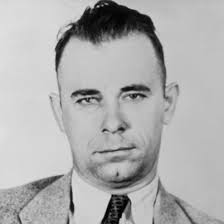 |
| John Dillinger On July 7, 1934, Dillinger meets with Billie Frechette's attorney at Schiller Street and Sacramento Boulevard, Chicago, to discuss Billie's appeal. Polly Hamilton (Dillinger's new squeeze) is nearby, but the attorney declines an offer to be introduced. |
Friday, July 6, 2012
Friday, July 6, 1934
Mother and I went up to Aunt Millie's in the afternoon. Daddy and Newt went fishing. Had fish and fried chicken for supper.
| July 6, 1934 newspaper advertisement for Coca-Cola's Handy Home Carton. |
Thursday, July 5, 2012
Thursday, July 5, 1934
Went over to Annie's (Ruth's step-grandmother). Down to Joe's for dinner. We went to Mart's for supper. It rained on the way back.
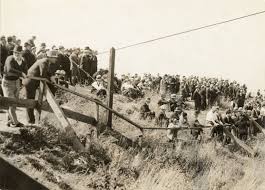 |
| "Bloody Thursday" - San Francisco, CA - July 5, 1934 During the 1934 strike by maritime workers and longshoremen, conflict erupted when the Industrial Association (consisting of employers and business interests) started moving goods from the piers to warehouses -- in an effort to break the strike. Bloody Thursday refers to July 5, 1934 -- and to the violence that ensued between strikers and their supporters, and the police trying to contain the strike. As goods began moving, police tried to clear the transportation track of strikers. When the strikers wouldn't budge, police began clubbing them and strikers retaliated by throwing rocks and bricks. |
Wednesday, July 4, 2012
Wednesday, July 4, 1934
I went down to Rita Mae's. She came up here. Had fish for dinner. Went up to Parallel for an ice cream social.
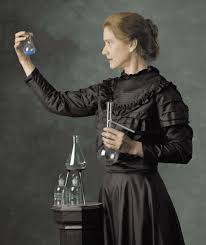 |
| Marie Curie (November 7, 1867 - July 4, 1934) Throughout her life, Mme. Curie actively promoted the use of radium to alleviate suffering. The importance of Mme. Curie's work is reflected in the numerous awards bestowed on her. She received many honorary science, medicine and law degrees and honorary memberships of learned societies throughout the world. Together with her husband, Pierre, she was awarded half of the Nobel Prize for Physics in 1903, for their study into the spontaneous radiation discovered by Becquerel, who was awarded the other half of the Prize. In 1911 she received a second Nobel Prize, this time in Chemistry, in recognition of her work in radioactivity. She also received, jointly with her husband, the Davy Medal of the Royal Society in 1903 and, in 1921, President Harding of the United States, on behalf of the women of America, presented her with one gram of radium in recognition of her service to science. |
Tuesday, July 3, 2012
July 3, 1934
Ruby was up here for dinner. We went to Emmets and Melvin's for lunch. Marie and Sue were there too.
 |
| Clay Center, Kansas cousins (L-R) Ruby, Rita Mae, Ruth and Gladys |
Monday, July 2, 2012
Monday, July 2, 1934
Daddy went to Clay. Rita Mae was up here. Daddy and Wayne went fishing. Rita Mae and I worked puzzles.
| American tennis player Sarah Palfrey at Wimbledon, London on July 2, 1934 She teamed with with Helen Jacobs to win the 1932, 1934, and 1935 U.S. women's doubles championships, but didn't win the women's doubles championship at Wimbledon until 1938 and 1939. She won the U.S. singles championship in 1941 and 1945. |
Sunday, July 1, 2012
Sunday, July 1, 1934
Didn't go to church or Sunday school. Gladys, Nellie, Wayne and Clarence were here for dinner. Went down to Mart's in evening.
 |
| The Chesterfield Nightclub 314 E Ninth Street, Kansas City, MO KC in the 30's: Rowdy Music Memories of America's Wildest City Capitol Records release produced by Dave E. Dexter, Jr. The Chesterfield Club featured a "businessman's lunch" served by waitresses who wore nothing but shoes and see-through cellophane aprons. Some of the girls had an affinity for poker and incorporated club, heart, diamond and spade designs into their "uniforms." The club was cited in 1933 for "allowing an indecent act to be exhibited," and it was shut down by a court order in April 1939 for encouraging "lewd and lascivious shows by female entertainers. Two months later, a fire destroyed the place. |
Subscribe to:
Posts (Atom)



